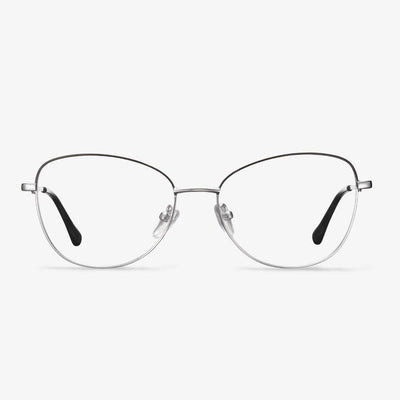Can You Put New Lenses in Old Frames?
In this section, we will show you how to replace new lenses with old frames. In general, optical shops will replace the lenses for you if your frames are in good condition and the shapes of the lenses is not too complicated.
So, can you put new lenses in old frames? Of course, you can do that if your old frame is good and shape of lenses is not too complicated.
However, glasses lens replacement depends on the quality of your existing frames, their conditions, and your prescription specifics. Not every pair of sunglasses or glasses for that matter can be reglazed. Sometimes fresh frames are required to match your new lenses. By far the most common reason for this would be because the existing frame is becoming brittle or is otherwise at risk of breaking. There is no point putting beautiful new lenses into a frame that breaks either during fitting or soon after.
In addition, when considering glasses lens replacement, you need to consider the materials of frames. In general, plastic frames are more likely to become brittle with age than metal frames. Of course, there are some other factors to be considered.
The refractive index of the lens is related to the thickness of the lens.
The main factors that determine if a pair of finished glasses are beautiful, portable, and comfortable depending on the thickness and thinness of the processed lenses. Depending on the material, the index of refraction is different. If you just look at the refractive index, the higher the refractive index at the same degree, the thinner the lens will be. The thinner the lens will be, and the more beautiful the lens will be. However, the higher the refractive index, it is not the better. You can choose the refractive index lens suitable for yourself. But the refractive index is not the only factor that determines lens thickness. Think about the distance between your eyes and the size of the frames you choose, which can affect the thickness of the lenses you match. The larger the pupil distance, the smaller the frame, and the thinner the lens.
Progressive Lens
Standard progressive lenses are multifocal lenses with three observation areas, farsightedness, intermediate vision, and nearsightedness. Unlike bifocals, there are no visible lines between each viewing area. They have a seamless, invisible design, where the optical power changes 'gradually' throughout the lens. Many people confuse 'bifocal' or 'trifocal' with 'progressive' but remember that bifocals and trifocals have visible lines in the lens, while progressive lenses do not. Because progressive lenses have no lines in the lens, they are more popular multifocal lenses than bifocal lenses.
The main observation area of the progressive lens is a far distance, the smaller area at the bottom of the lens is used for myopia, and the middle area in the middle is smaller. Standard progressive glasses are very suitable for general purpose glasses, focusing on hyperopia activities (such as driving and walking) and sufficient area in the lenses for nearsighted activities (such as reading and computer use). The left and right sides or 'convex corners' of the lens are deliberately blurred to achieve an invisible design. The clearest line of sight in the gradual process is from the center to the top of the lens.
INMIX Driving Glasses
Inmix has tried many functional innovations, like an ultralight frame that weighs only seven grams and can float on water, a blue lens that blocks radiation from computer and mobile phone screens, and an allergy nose pad. Inmix Glass is an attempt to distance itself from its competitors with a strong visual style. The performance of Inmix glasses is beyond its young brand positioning. The brand competitiveness of the old brand is not lost at all. Opening the affordable era of glasses, it truly realizes the ecological chain from factory to consumer, and gives consumers the most cost-effective high-quality glasses. Parity and quality make the sales volume double every year, and the sales volume in 2015 is more than the sum of the previous years.
Proof Eyewear
The origins of Proof Eyewear date back to 1954. The company went global from garage to sustainable eyewear in just a few years. They provide products handmade from sustainable materials, including sustainably sourced wood, biodegradable cotton-based acetate, and recycled aluminum. The acetic acid Rx series features an environmentally friendly frame and hand-layered cotton-based acetate fiber. It is a completely renewable, biodegradable, hypoallergenic alternative to petroleum-based plastics. Some styles come with sustainable wood or metal detailing, and most come with clear or blue-light lenses. Wood harvesting is one of the best sustainable sources of handmade wood. The hand-layered structure creates durability with a unique environmentally friendly design. All frames come with stainless steel spring hinges and a hand-polished waterproof/perspiration resistant natural plant-based sealant.
What Is Blue Light Glasses?
Blue light glasses are designed to absorb excess blue light from the many kinds of digital screens in our home and the office spaces. Blue light glasses is becoming more and more popular because it can protect the eyes from the invisible but harmful blue light projected by digital screens. With them, you can enjoy a life with less eye strain and a healthier sleep cycle.
With so many advantages, you may ask whether I can wear blue light glasses all the time. The following part shows some information.
What are polarized lenses for?
Polarized lenses contain a layer of polarizing plates in which molecular chains form a light-grating structure in which dichromatic pigments, which absorb polarized light, are evenly distributed. A beam of light is absorbed when it vibrates in the same direction as the bars of the molecular chain of the polarized lens. The grating direction formed by the molecular chain of the polarizer is the axial direction of the polarizer, which is generally horizontal. When polarized lenses are worn, they absorb all the light that vibrates horizontally, thus absorbing the glare and preventing it from reaching the eyes.











































